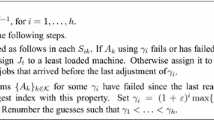Abstract
The paper discusses a rarely used metric that is well suited to evaluate online schedules for independent jobs on massively parallel processors. The metric is based on the total weighted completion time objective with the weight being the resource consumption of the job. Although every job contributes to the objective value, the metric exhibits many properties that are similar to the properties of the makespan objective. For this metric, we particularly address nonclairvoyant online scheduling of sequential jobs on parallel identical machines and prove an almost tight competitive factor of 1.25 for nondelay schedules. For the extension of the problem to rigid parallel jobs, we show that no constant competitive factor exists. However, if all jobs are released at time 0, List Scheduling in descending order of the degree of parallelism guarantees an approximation factor of 2.
Similar content being viewed by others
References
Avidor, A., Azar, Y., & Sgall, J. (2001). Ancient and new algorithms for load balancing in the p-norm. Algorithmica, 29(3), 422–441.
Bansal, N., & Pruhs, K. (2003). Server scheduling in the l p norm: a rising tide lifts all boats. In ACM symposium on theory of computing (STOC) (pp. 242–250). Berlin: Springer.
Bharadwaj, V., Robertazzi, T. G., & Ghose, D. (1996). Scheduling divisible loads in parallel and distributed systems. Los Alamitos: IEEE Computer Society Press.
Cirne, W., & Berman, F. (2001). A model for moldable supercomputer jobs. In Proceedings of the 15th international parallel & distributed processing symposium (IPDPS-01) (p. 59). Berlin: Springer.
Downey, A. B., & Feitelson, D. (1999). The elusive goal of workload characterization. ACM SIGMETRICS Performance Evaluation Review, 26(4), 14–29
Feitelson, D., Rudolph, L., Schwiegelshohn, U., Sevcik, K., & Wong, P. (1997). Theory and practice in parallel job scheduling. In D. Feitelson & L. Rudolph (Eds.), Lecture notes in computer science: Vol. 1291. IPPS’97 workshop: job scheduling strategies for parallel processing (pp. 1–34). Berlin: Springer.
Franke, C., Hoffmann, F., Lepping, J., & Schwiegelshohn, U. (2008). Development of scheduling strategies with genetic fuzzy systems. Applied Soft Computing Journal, 8(1), 706–721
Garey, M., & Johnson, D. (1979). Computers and intractability: a guide to the theory of NP-completeness. New York: Freeman.
Graham, R. (1966). Bounds for certain multiprocessor anomalies. Bell System Technical Journal, 45, 1563–1581.
Graham, R., Lawler, E., Lenstra, J., & Kan, A.R. (1979). Optimization and approximation in deterministic sequencing and scheduling: a survey. Annals of Discrete Mathematics, 15, 287–326.
Hussein, M., & Schwiegelshohn, U. (2006). Utilization of nonclairvoyant online schedules. Theoretical Computer Science, 362, 238–247.
Kawaguchi, T., & Kyan, S. (1986). Worst case bound of an LRF schedule for the mean weighted flow-time problem. SIAM Journal on Computing, 15(4), 1119–1129.
Lee, C. B., & Snavely, A. (2007). Precise and realistic utility functions for user-centric performance analysis of schedulers. In HPDC ’07: proceedings of the 16th international symposium on high performance distributed computing (pp. 107–116). Berlin: Springer.
Lee, C. B., Schwartzman, Y., Hardy, J., & Snavely, A. (2004). Are user runtime estimates inherently inaccurate? In Proceedings of the 10th workshop on job scheduling strategies for parallel processing (pp. 153–161). Berlin: Springer.
Lifka, D. (1995). The ANL/IBM SP scheduling system. In D. Feitelson & L. Rudolph (Eds.), Lecture notes in computer science: Vol. 949. IPPS’95 workshop: job scheduling strategies for parallel processing (pp. 295–303). Berlin: Springer.
Naroska, E., & Schwiegelshohn, U. (2002). On an online scheduling problem for parallel jobs. Information Processing Letters, 81(6), 297–304.
Pinedo, M. (2002). Scheduling: theory, algorithms, and systems (2nd ed.). New Jersey: Prentice-Hall.
Queyranne, M. (1993). Structure of a simple scheduling polyhedron. Mathematical Programming, 58(2), 263–285.
Schwiegelshohn, U., & Yahyapour, R. (2000). Fairness in parallel job scheduling. Journal of Scheduling, 3(5), 297–320.
Shmoys, D., Wein, J., & Williamson, D. (1995). Scheduling parallel machines on-line. SIAM Journal on Computing, 24(6), 1313–1331.
Author information
Authors and Affiliations
Corresponding author
Rights and permissions
About this article
Cite this article
Schwiegelshohn, U. A system-centric metric for the evaluation of online job schedules. J Sched 14, 571–581 (2011). https://doi.org/10.1007/s10951-010-0206-9
Published:
Issue Date:
DOI: https://doi.org/10.1007/s10951-010-0206-9




